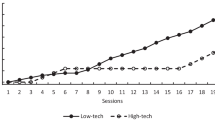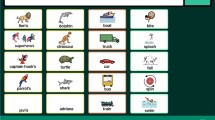Abstract
Although the last decade has welcomed evidence that individuals with Rett syndrome (RTT) can communicate using alternative and augmentative communication (AAC), less is known about effective procedures for teaching various component skills required for expressive communication of individuals with complex communication needs. The purpose of the current study was to evaluate the effects of systematic individualized instruction procedures on the page-linking skills of individuals with RTT. A nonconcurrent multiple baseline design across participants was used to evaluate independent and accurate responding utilizing both a high-tech and low-tech AAC device for three participants. All sessions were conducted in the participants’ homes by their parents with remote coaching from a researcher via telehealth. Results indicated that for all three participants, individualized procedures that included behavior chaining, differential reinforcement, and delayed prompting were effective for teaching page-linking in both a high-tech and a low-tech AAC device. Directions for future research and practice are discussed.




Similar content being viewed by others

Data Availability
Data are available upon request from the first author.
References
Achmadi, D., Kagohara, D., Van Der Meer, L., O’Reilly, M., Lancioni, G., Sutherland, D., Lang, R., Marshik, P. B., Green, V. A., & Sigafoos, J. (2012). Teaching advanced operation of an iPod-based speech-generating device to two students with autism spectrum disorders. Research in Autism Spectrum Disorders, 6(4), 1258–1264. https://doi.org/10.1016/j.rasd.2012.05.005
Albert, K. M., Carbone, V. J., Murray, D. D., Hagerty, M., & Sweeney-Kerwin, E. J. (2012). Increasing the mand repertoire of children with autism through the use of an interrupted chain procedure. Behavior Analysis in Practice, 5(2), 65–76. https://doi.org/10.1007/BF03391825
Alzrayer, N. M., Banda, D. R., & Koul, R. (2017). Teaching children with autism spectrum disorder and other developmental disabilities to perform multistep requesting using an iPad. Augmentative and Alternative Communication, 33(2), 65–76. https://doi.org/10.1080/07434618.2017.1306881
Anderson, C. M., & Long, E. S. (2002). Use of a structured descriptive assessment methodology to identify variables affecting problem behavior. Journal of Applied Behavior Analysis, 35(2), 137–154. https://doi.org/10.1901/jaba.2002.35-137
Bartolotta, T. E., Zipp, G. P., Simpkins, S. D., & Glazewski, B. (2011). Communication skills in girls with Rett syndrome. Focus on Autism and Other Developmental Disabilities, 26(1), 15–24. https://doi.org/10.1177/1088357610380042
Boesch, M., Wendt, O., Subramanian, A., & Hsu, N. (2013). Comparative efficacy of the Picture Exchange Communication System (PECS) versus a speech-generating device: Effects on requesting skills. Research in Autism Spectrum Disorders, 7(3), 480–493. https://doi.org/10.1016/j.rasd.2012.12.002
Brady, N. C., Saunders, K. J., & Spradlin, J. E. (1995). A conceptual analysis of request teaching procedures for individuals with severely limited verbal repertoires. The Analysis of Verbal Behavior, 12, 43–52. https://doi.org/10.1007/bf03392896
Brodhead, M. T., Al-Dubayan, M. N., Mates, M., Abel, E. A., & Brouwers, L. (2016). An evaluation of a brief video-based multiple-stimulus without replacement preference assessment. Behavior Analysis in Practice, 9(2), 160–164. https://doi.org/10.1007/s40617-015-0081-0
Byiers, B. J., Dimian, A., & Symons, F. J. (2014). Functional communication training in Rett syndrome: A preliminary study. American Journal on Intellectual and Developmental Disabilities, 119(4), 340. https://doi.org/10.1352/1944-7558-119.4.340
Carr, J. (2005). Recommendations for reporting multiple-baseline designs across participants. Behavioral Interventions, 20(3), 219–224. https://doi.org/10.1002/bin.191
Chen, M., Hyppa-Martin, J. K., Reichle, J. E., & Symons, F. J. (2016). Comparing single case design overlap-based effect size metrics from studies examining speech generating device interventions. American Journal on Intellectual and Developmental Disabilities, 121(3), 169–193.
Cooper, J. O., Heron, T. E., & Heward, W. L. (2020). Applied behavior analysis (3rd ed.). Pearson.
Ellaway, J., & Christodoulou, C. (2001). Rett syndrome: Clinical characteristics and recent genetic advances. Disability and Rehabilitation, 23(3–4), 98–106. https://doi.org/10.1080/09638280150504171
Freeman, K. A., Anderson, C. M., & Scotti, J. R. (2000). A structured descriptive methodology: Increasing agreement between descriptive and experimental analyses. Education and Training in Mental Retardation and Developmental Disabilities, 35(1), 55–66. http://www.jstor.org/stable/23879707
Fisher, W., Piazza, C. C., Bowman, L. G., Hagopian, L. P., Owens, J. C., & Slevin, I. (1992). A comparison of two approaches for identifying reinforcers for persons with severe and profound disabilities. Journal of Applied Behavior Analysis, 25, 491–498. https://doi.org/10.1901/jaba.1992.25-491
Frost, L. A., & Bondy, A. (2002). The Picture Exchange Communication System training manual. Pyramid Educational Consultants.
Gast, D. L., & Ledford, J. R. (Eds.). (2018). Single Case Research Methodology: Applications in Special Education and Behavioral Sciences (3rd ed.). Routledge. https://doi.org/10.4324/9781315150666
Hagberg, B., & Witt-Engerstrom, I. (1986). Rett syndrome: A suggested staging system for describing impairment profile with increasing age towards adolescence. American Journal of Medical Genetics, 24(1), 47–59. https://doi.org/10.1002/ajmg.1320250506
Hagberg, B., & Zoghbi, H. Y. (2002). Clinical manifestations and stages of Rett syndrome. Mental Retardation and Developmental Disabilities Research Reviews, 8(2), 61–65m. https://doi.org/10.1002/mrdd.10020
Harvey, M., May, T., & Kennedy, M. (2004). Nonconcurrent multiple baseline designs and the evaluation of educational systems. Journal of Behavioral Education, 13(4), 267–276. https://doi.org/10.1023/B:JOBE.0000044735.51022.5d
Koppenhaver, D. A., Erickson, K. A., Harris, B., McLellan, J., Skotko, B. G., & Newton, R. A. (2001). Storybook-based communication intervention for girls with Rett syndrome and their mothers. Disability and Rehabilitation, 23(3–4), 149–159. https://doi.org/10.1080/09638280150504225
Murphy, D., Lyons, R., Carroll, C., Caulfield, M., & de Paor, G. (2018). Communication as a human right: Citizenship, politics and the role of the speech-language pathologist. International Journal of Speech-Language Pathology, 20(1), 16–20. https://doi.org/10.1080/17549507.2018.1404129
National Institute of Neurological Disorders and Stroke (NINDS). (2021). Rett Syndrome FactSheet. https://www.ninds.nih.gov/Disorders/Patient-Caregiver-Education/FactSheets/Rett-Syndrome-Fact-Sheet
Scruggs, T., Mastropieri, M., & Casto, G. (1987). The quantitative synthesis of single-subject research. Remedial and Special Education, 8(2), 24–33. https://doi.org.ezp1.lib.umn.edu/10.1177/074193258700800206
Reichle, J., Simacek, J., Wattanawongwan, S., & Ganz, J. (2019). Implementing aided augmentative communication systems with persons having complex communicative needs. Behavior Modification, 43(6), 841–878. https://doi.org/10.1177/0145445519858272
Sigafoos, J., & Iacono, T. (1993). Selecting augmentative communication devices for persons with severe disabilities: Some factors for educational teams to consider. Australia and New Zealand Journal of Developmental Disabilities, 18(3), 133–146. https://doi.org.ezp2.lib.umn.edu/10.1080/07263869300034901
Sigafoos, J., Woodyatt, G., Keen, D., Tait, K., Tucker, M., Roberts-Pennell, D., & Pittendreigh, N. (2000). Identifying potential communicative acts in children with developmental and physical disabilities. Communication Disorders Quarterly, 21(2), 77–86. https://doi.org/10.1177/152574010002100202
Scruggs, T. E., & Mastropieri, M. A. (2001). How to summarize single-participant research: Ideas and applications. Exceptionality, 9(4), 227–244. https://doi.org/10.1207/S15327035EX0904_5
Simacek, J., Reichle, J., & McComas, J. (2016). Communication intervention to teach requesting through aided AAC for two learners with Rett syndrome. Journal of Developmental and Physical Disabilities, 28(1), 59–81. https://doi.org/10.1007/s10882-015-9423-7
Tarlow, K. R., & Penland, A. (2016). Outcome assessment and inference with the Percentage of Nonoverlapping Data (PND) single-case statistic. Practice Innovations, 1(4), 221–233. https://doi.org/10.1037/pri0000029
Unholz-Bowden, E., Girtler, S., Shipchandler, A., Kolb, R., & McComas, J. (2023). Use of augmentative and alternative communication by individuals with Rett syndrome part 2: High-tech and low-tech devices. Journal of Developmental and Physical Disabilities. https://doi.org/10.1007/s10882-023-09902-y
Urbanowicz, A., Leonard, H., Girdler, S., Ciccone, N., & Downs, J. (2016). Parental perspectives on the communication abilities of their daughters with Rett syndrome. Developmental Neurorehabilitation, 19(1), 17–25. https://doi.org/10.3109/17518423.2013.879940
Watson, P. J., & Workman, F. A. (1981). The nonconcurrent multiple baseline across individuals design: An extension of the traditional multiple baseline design. Journal of Behavior Therapy and Experimental Psychology, 12, 257–259. https://doi.org/10.1016/0005-7916(81)90055-0
Funding
This study was funded by grant #1R21DC015021.
Author information
Authors and Affiliations
Contributions
All authors contributed toward research conceptualization, study design, and data analysis. Data collection was performed by Shawn N. Girtler, Emily Unholz-Bowden, Alefyah Shipchandler, and Rebecca L. Kolb. Shawn N. Girtler, Emily Unholz-Bowden, and Alefyah Shipchandler contributed toward writing. Editing was performed by Rebecca L. Kolb and Jennifer J. McComas.
Corresponding author
Ethics declarations
Conflicts of Interest/Competing interests
The authors declare that they have no conflict of interest.
Ethics Approval
This study was approved by the University of Minnesota’s Institutional Review Board. All ethics procedures and codes based on the Declaration of Helsinki, the Institutional Review Board, and the Behavior Analyst Certification Board Professional and Ethical Compliance Code for Behavior Analysts were followed during the study.
Informed Consent
Written informed consent was obtained from a parent/legal guardian of each child participant.
Additional information
Publisher's Note
Springer Nature remains neutral with regard to jurisdictional claims in published maps and institutional affiliations.
Rights and permissions
Springer Nature or its licensor (e.g. a society or other partner) holds exclusive rights to this article under a publishing agreement with the author(s) or other rightsholder(s); author self-archiving of the accepted manuscript version of this article is solely governed by the terms of such publishing agreement and applicable law.
About this article
Cite this article
Girtler, S.N., Unholz-Bowden, E.K., Shipchandler, A. et al. Use of Augmentative and Alternative Communication by Individuals with Rett Syndrome Part 1: Page-Linking. J Dev Phys Disabil 36, 125–145 (2024). https://doi.org/10.1007/s10882-023-09903-x
Accepted:
Published:
Issue Date:
DOI: https://doi.org/10.1007/s10882-023-09903-x



